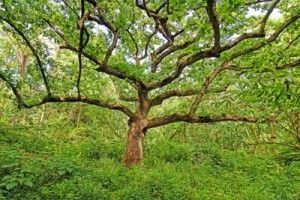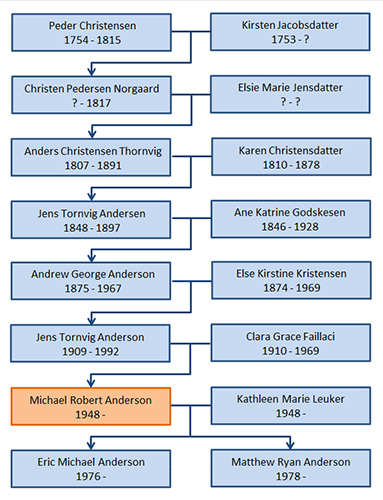
Thanks to the hard work and perseverance of my cousin Gladys Green and others, a significant amount of information about our family has been researched and compiled over the past 40 years. Although I was aware of Gladys’ efforts, I really didn’t think much about it at the time. After all, having grown up on “Dane Hill” literally surrounded by aunts, uncles and cousins, the composition of the Anderson Family seemed pretty obvious to me.
After my father’s death in 1992, my siblings and I divided up old photos and other mementos from his house and I obtained copies of the following documents that Gladys had prepared:
- Anderson Family Tree, March 1983
- Anderson Family Tree, Additions and Corrections, October 1985
- Anderson Family Tree, Second Update, Additions and Corrections, August 1990
- Anderson Family Tree, Third Update, Additions and Corrections, November 1995
- Kristensen Vodde Family Tree, March 1983
- Kristensen Vodde Family Tree, Additions and Corrections, October 1985
My sister Mary Ann later sent me additional information that Marlowe Nelson and Rick Larsen had uncovered about Danish ancestors dating back to the 18th century.
The following are excerpts from the notes that Gladys Green included in the March 1983 edition of the Anderson Family Tree:
- We started the family tree in 1975 as a result of our children asking “How is So and So related to us?” We started taking our book to family gatherings. As we found out death dates of the family members we went to the Racine Library and looked thru microfilm of obituaries in the Racine Journal Times to gather more complete information.
- We visited with Hilda Nelson and she gave us quite a bit of information including that which son Marlowe had located on his trip to Denmark in 1979.
- In 1981 we started writing letters to relatives giving them the information we had and putting in blanks for what was missing and including a self-addressed envelope. It was really exciting getting the letters back, the relatives were so cooperative and very interested in getting a family tree made. Many letters included more names and addresses to write to.
- One of the most exciting times to us was when we found Grandma Elsie Anderson’s birth as it was recorded in the church records on the Danish micro-film.
I didn’t want this information to get lost but I wanted a better way to revise and update the lists so I decided to put the available data onto my computer. For this purpose I purchased a copy of Family Tree Maker. So far I have over 450 names entered into the computerized version of the Anderson Family Tree. The data that were compiled by Gladys Green and Marlowe Nelson include many more names than this since they have been working on both the Anderson and the Nelson family trees.
I’m not able to make the entire Anderson Family Tree available for viewing on this web page. However, to illustrate some of the information that has been gathered to date, the chart below shows 8 generations of Anderson males from my sons up to my grandfather’s grandfather’s grandfather.

Some interesting things to note:
- My father’s name was Jens Tornvig Anderson. His grandfather had the same name. Although it doesn’t show on this list, Anders Christensen Thornvig’s maternal grandfather was also named Jens Andersen (no middle name is listed).
- If you are familiar with Scandinavian names you are probably aware that Danish names usually end in “-sen” rather than “-son.” Although Andrew George (my grandfather) spelled his name Anderson, his father’s name was spelled Andersen. Gladys’ notes don’t mention this, but I wonder if this was one of those accidental changes that happened to many immigrant names from that generation as they passed through Ellis Island.
- The older generations of Danes used a patronymic system of naming. This meant that the children’s last names were based on their father’s first name. Male names ended in “-sen” and female names ended in “-datter.” Thus, as you look farther back, neither Anderson nor Andersen is the paternal family name. My great-grandfather Jens became an Andersen because his father’s first name was Anders. You can also see that the earlier spouse names all ended in “-datter.”
- One of Glady’s references points out that tracking down Scandinavian relatives is further complicated by the fact that very few given names were used. “In Denmark in 1787 approximately 15 male given names were used by 90% of the male population, on the female side the situation was about the same.” (Finn A. Thomsen, A Genealogical Guidebook and Atlas of Denmark.)
Unfortunately, I haven’t been able to keep the family tree up to date. There are so many new branches of which I am unaware. I recently shared my database with two relatives that are a couple of generations younger than I am so I am hopeful that Gladys’ work will live on and grow through them.
If you are interested in genealogy, there’s a lot of information available on the internet. In addition to the Family Tree Maker web site mentioned above, more information about genealogy can be found at The Ellis Island Foundation and My Danish Roots. Have fun and pass the Kringle!